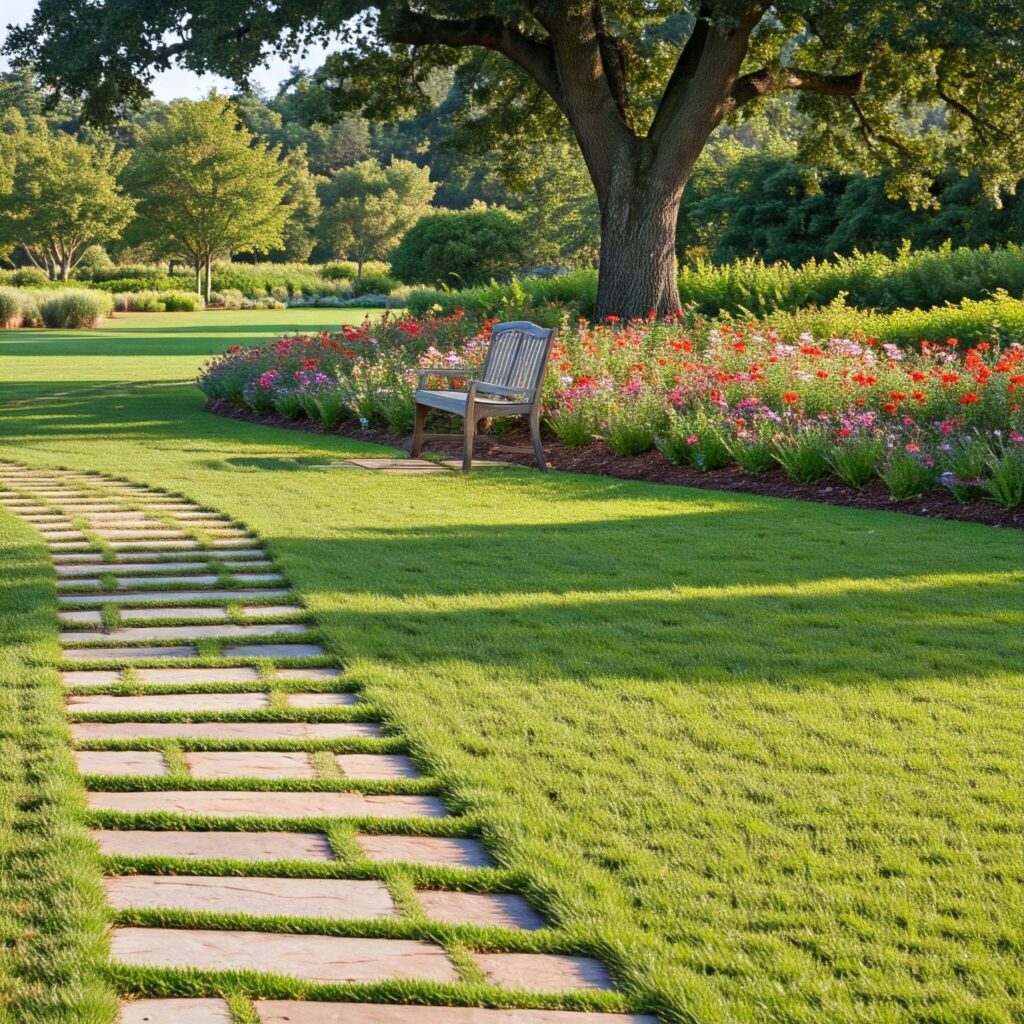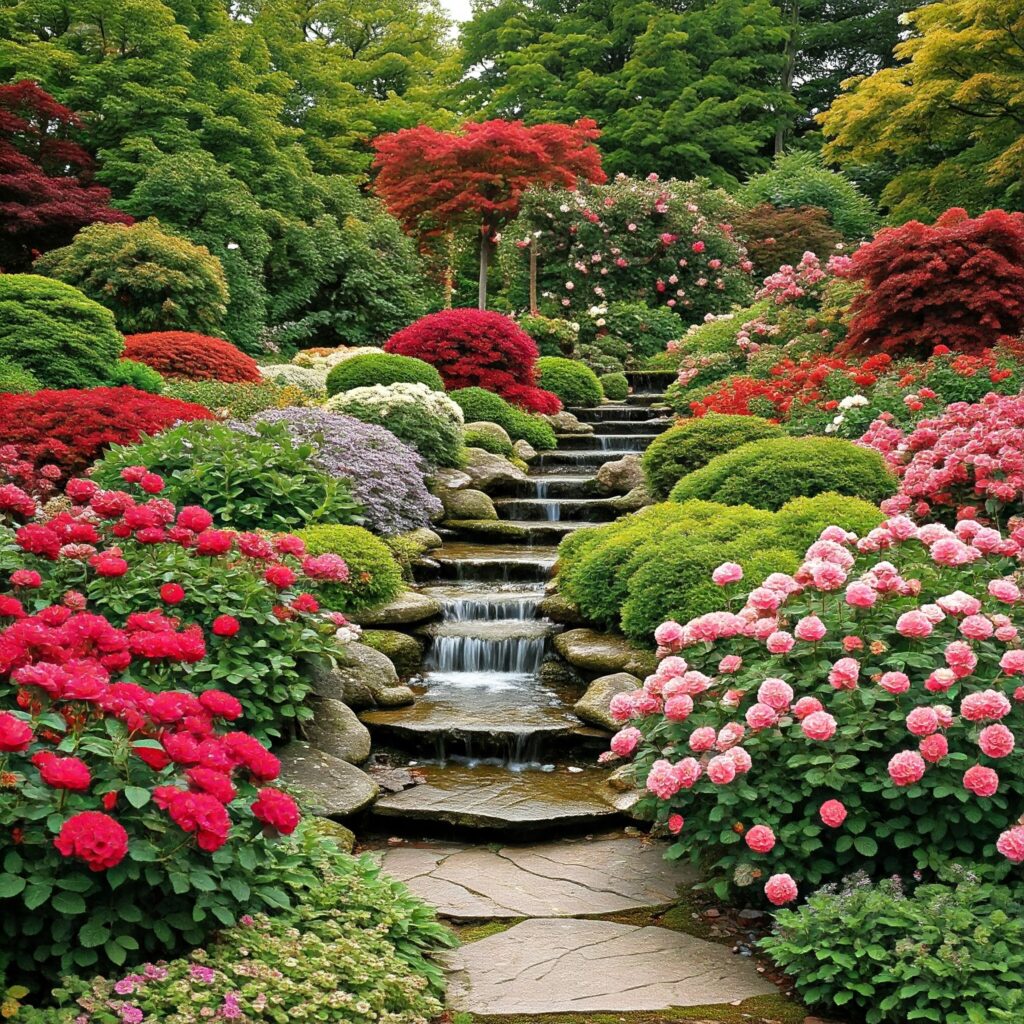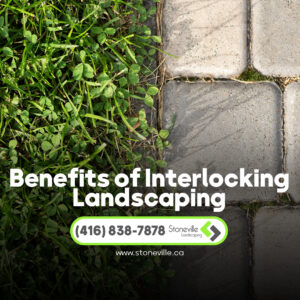Create an Oasis with Landscape Design
At The Stoneville, we believe that your landscape can be an oasis that thrives in harmony with nature without weighing you down. Our philosophy focuses on regenerative design inspired by our unique Life-Scape methodology. This approach, detailed in Monique Allen’s book Stop Landscaping, Start Designing Life, goes beyond aesthetics to create a sustainable ecosystem. To be clear, sustainability does not mean neglect or lack of maintenance. This means working in a way that encourages balance and harmony with nature so that you are not a slave to gardening.
Life-Scape’s restorative designs aren’t just about making beautiful places. They are about creating outdoor oases that thrive in harmony with nature. This approach offers many advantages. While the regeneration landscape is wilder than the average suburban landscape, it is still orderly. By incorporating native plants, companion planting, and avoiding synthetic chemical treatments, you create a haven for pollinators like butterflies and bees while providing a safe play space for children and pets and peace of mind for adults, young and old. All of these are critical to healthy communities. This approach can create healthy ecosystems in a backyard.
Tips and Ideas for a Thriving Backyard Garden
Site Analysis – Site analysis is the cornerstone of any successful and sustainable landscape design. Just like building a house on a solid foundation, understanding the unique characteristics of your yard is essential to creating a thriving outdoor space. By applying systems thinking, you can plan like a pro! The full analysis of the site is as follows:
Map your backyard, measure its size and shape, and draw a rough plan to identify existing features such as trees, structures, and utilities.
Track sun exposure throughout the day, noting areas that receive full sun, part sun/shade, or full shade. This means considering the structures on the site (which provide dense shade) and trees that provide varying degrees of shade. This will later determine the choice of plant.
Observe Drainage Patterns – Pay attention to areas prone to waterlogging, runoff, or drought to ensure proper grading and plant placement.
Soil quality is also very important. Be sure to check for tree root systems and possible ledge protrusions that occupy large areas of the soil horizon.
Consider soil testing as part of your site analysis toolbox.
Finally, consider wind patterns, the prevailing direction, its effect on plant selection, and your comfort while enjoying the space.
Consider Your Needs and Dreams – Equally important is developing a vision that reflects your needs and dreams for your future Life-Scape. Are you craving a quiet retreat to relax? A space to entertain friends and family? Maybe weaving a vegetable garden into the mix will make you happy? Based on the facts revealed by the site analysis and your aspirations, you can identify challenges and opportunities to turn your backyard into a personal sanctuary.
Think about your time horizon and resources. How long will you live in this house? How long will it take to develop this vision? Can you build it step by step? What level of funding do you need to build and maintain it? Answering questions like these before you put the shovel in the ground will help you plan so you can gather the necessary resources to ensure a stellar outcome.

Backyard Landscaping Design: Tips for Reviving
Turn Your Vision into Reality – Now that you’ve analyzed your site and envisioned your dream backyard, it’s time to turn that vision into reality. The key question at this point is how you will make this a reality. Do you arrange the design details or hire a designer? Will you build your own Life-Scape or partner with a landscape company to complete all or part of the project? While these questions seem simple to read, it’s a common beginner’s mistake to think about them without first thinking about what’s covered in this blog.
It takes time to create a regenerative landscape that is truly sustainable, environmentally friendly, and satisfying. We call it the long game of dreaming, designing, planning and building. Rushing is a sure way to miss essential elements of the process and hinder your success. Investing time and money into land development can be financially and emotionally devastating, regardless of how well the system is cared for after completion.
Five great reasons to grow your product include:
It’s More Nutritious A diet with a variety of fresh fruits and vegetables is more varied and healthier, and full of vitamins, minerals, and antioxidants to protect your cells. Foods with the shortest time between harvesting and eating retain the most nutritional value.
A new call to action
This helps you get vitamin D not from the produce itself, but from the sunlight you’re exposed to when you spend time gardening outdoors. Vitamin D protects against certain diseases and helps you have healthy bones and teeth.
Provides healthy activity The physical activity required in gardening can improve heart health and immune system response. reduce heart rate and stress; and increases movement skills, flexibility and body strength. Regular exercise helps reduce stress, anxiety and depression while increasing energy.
It will save you money. Spending a little on seeds, starters, and gardening supplies can save you a lot at the supermarket.
Better for the environment Even organic produce bought at the supermarket often needs to be transported long distances, burning fossil fuels and contributing to climate change. Growing your own produce enables you to better control and limit the use of chemical fertilizers, herbicides and pesticides.
Now, you might be tempted to say, “Why bother growing my own when supermarkets have so many fruits and vegetables?” And, yes, while many supermarkets are usually filled with fresh, colorful produce that appears to be “healthy,” it may not all be as nutritious as it seems.
So what’s next? Home Landscaping Ideas
Take the time to allow yourself to dream and map out a plan. These two steps, while not transformative in themselves, are fundamental to success. Next is to seek guidance. Our blog is full of ideas and tips to help you be thoughtful about your Life-Scape goals and project planning. Use these resources to guide your conversations with landscape professionals in your area.
If you live in our Massachusetts service area, feel free to call to get on the waiting list for our free landscape discovery session. In this call, we can explore project direction and scope, answer project scheduling questions, and provide insightful design tips. If you like what you learn, you can book a personal on-site landscape assessment, where our team of experienced professionals will come to your home to share ideas on how to transform your landscape into a living space.

Home Landscaping Ideas: Transforming Your Outdoor Space
A well-designed landscape can significantly increase the beauty and value of your home. It’s more than just grass and a few trees. This extension of your living space is a place to relax, entertain and connect with nature. Here are some inspiring home landscape ideas to get you started:
- Zen garden
Embrace the tranquility with a minimalist Zen garden.
Key features: smooth, pebbled sand, carefully placed rocks, a small water feature (like a simple fountain), and low-maintenance, well-kept plants like bamboo or Japanese maple.
Inspiration: Focus on simplicity, balance and harmony.
- Cottage garden
Create a romantic and whimsical atmosphere with a cottage garden.
Key features: abundant flowers such as roses, daisies and lilies, winding paths, rustic fences, and vines.
Inspiration: Think English countryside, full of color and charm.
- Modern minimalist garden
Use clean lines and geometric shapes for a contemporary look.
Key features: minimalist plantings with prominent forms and textures, smooth surfaces such as concrete or polished stone, and abstract sculptures.
Inspiration: Less is more. Focus on creating a sense of calm and order.
- Tropical oasis
Escape to the tropics in your backyard.
Key features: Lush foliage with palm trees, ferns, and flowering tropical plants, water features such as ponds or waterfalls, and comfortable outdoor seating areas.
Inspiration: Create a vibrant and relaxing retreat with a touch of whimsical flair.
- Escape from the Mediterranean
Capture the essence of the Mediterranean with a sun-drenched landscape.
Key features: terracotta pots, stone paths, drought-tolerant plants such as lavender, rosemary, and olive trees, and a small herb garden.
Inspiration: Create a calm and inviting space that evokes the warmth and charm of the Mediterranean Sea.
- Edible garden
Grow your own food while adding beauty to your landscape.
Key Features: Raised garden beds, fruit trees, vegetable patches, and herb gardens.
Inspiration: Create a productive and visually appealing space that provides fresh, local produce.
- Xeriscape garden
Embrace sustainability with a xeriscape garden.
Key features: drought tolerant plants, efficient irrigation systems and use of mulch to reduce water loss.
Inspiration: Create a beautiful, low-maintenance landscape that saves water.
Key considerations for all landscapes
Climate: Choose plants that are well suited to your local climate.
Sunlight: Consider the amount of sunlight your yard receives during the day.
Soil Type: Determine your soil type and correct it if needed.
Space: Plan your landscape to make the most of your available space.
Maintenance: Consider the level of maintenance required for different plants and features.
Hiring a professional landscaper
A professional landscaper can help you:
Create a master plan: They can assess your property, understand your needs and vision, and create a custom plan.
Choose the right plants: They specialize in plant selection and ensure you choose plants that will thrive in your climate and soil.
Correct installation of features: They have the skills and equipment necessary to install difficult features such as patios, walkways and retaining walls.
Ongoing maintenance: They can provide ongoing maintenance services such as pruning, weeding and fertilizing.
By carefully considering these ideas and working with a qualified professional, you can transform your outdoor space into a beautiful and enjoyable oasis.






